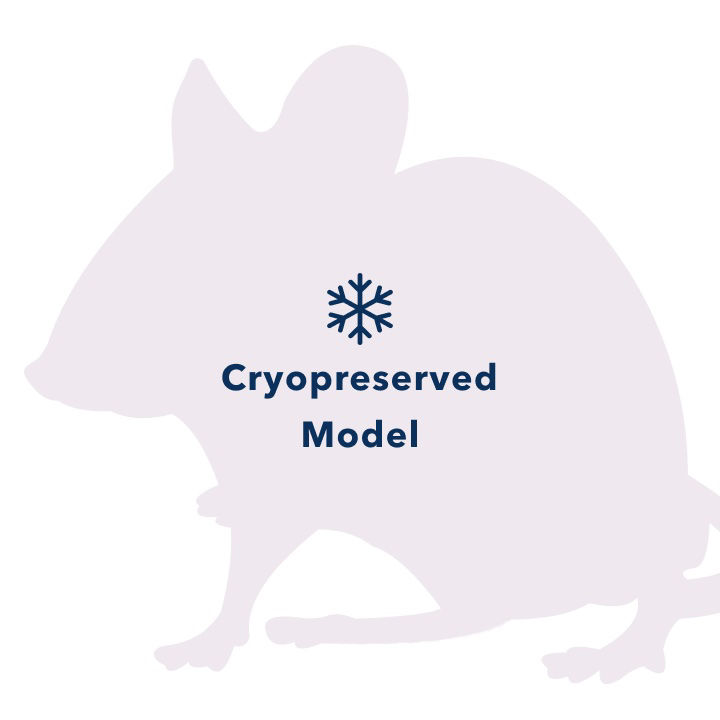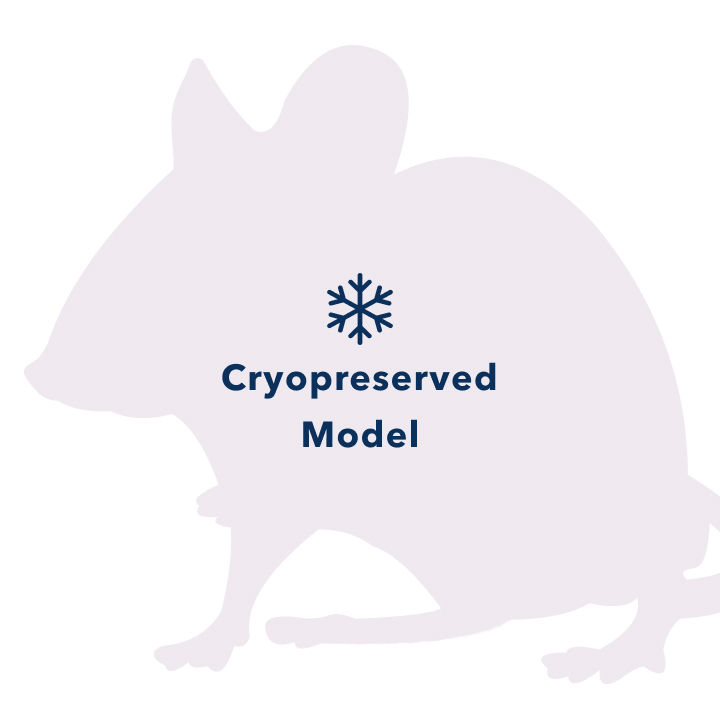Application Areas:
Stat1

| Model No. | Nomenclature | Genotype |
|---|---|---|
| 2045-F | 129S6/SvEv-Stat1tm1Rds | ko/ko |
| 2045-M | 129S6/SvEv-Stat1tm1Rds | ko/ko |
- Description
- Price & Licensing
- Health Report
- Overview
- Genetics
- Guides & Publications
- Applications & Therapeutic Areas
- Transit, Housing & Welfare
- Diet
Overview
Nomenclature: 129S6/SvEv-Stat1tm1Rds
- Contains a homozygous disruption of the Stat1 gene and complete lack of functional STAT1 proteins
- The JAK-STAT signaling pathway has been implicated in mediating biologic responses induced by many cytokines
- Homozygous mice develop normally
- Deficient immune cell response to alpha(α) and gamma(γ) interferons
- Extreme susceptibility to infections by microbial pathogens and viruses
- Could be used as sentinel animals for evaluating the health status of a mouse colony
- Accelerated and amplified development of chemically-induced and spontaneous tumors
- Useful in determining the role of a variety of cytokines in immune responses, the role of STAT1 protein in mediating interferon-dependent responses, and the roles of tumor cells and immune cells in mediating tumor cell destruction
Recommended Control
The recommended control for this model is 129SVE.
Origin
The Stat1 mouse was developed in the laboratory of Robert Schreiber at the Washington University School of Medicine. The model was created by targeting the Stat1 gene in GS-1 ES cells and injecting the targeted cells into blastocysts. Heterozygotes for the mutation were produced from the chimeras and intercrossed to generate homozygotes. Taconic received stock in 1997. The mice were embryo transfer derived. The original Stat1 model (000679-M) differed from the Taconic 129S6 at two biochemical loci, Pgm1 and Gpi1. In January 2002, the original Stat1 line was backcrossed to the Taconic 129S6/SvEvTac, and animals were selected to match the Pgm1c and Gpi1b alleles of the 129S6. The selected heterozygotes were intercrossed to homozygosity. The line is maintained through incrossing of homozygous mice. This improvement makes the 129S6/SvEvTac a more perfectly matched control for the Stat1 model.
Genetics
Guides & Publications
Initial Publication:
Meraz MA, White JM, Sheehan KC, Bach EA, Rodig SJ, Dighe AS, Kaplan DH, Riley JK, Greenlund AC, Campbell D, Carver-Moore K, DuBois RN, Clark R, Aguet M, Schreiber RD. (1996) Targeted disruption of the Stat1 gene in mice reveals unexpected physiologic specificity in the JAK-STAT signaling pathway. Cell, 84(3):431-442.
Applications & Therapeutic Areas
- Immunology
- Inflammation
- Infectious Disease
Transit, Housing & Welfare
Need more info? Click the live chat button or Contact Us
Packing Practices
Taconic standard practice is to recombine animals of different home cages and/or ages from a single model and sex during packing, except in specific cases where Taconic's animal welfare policy prohibits recombination due to aggression or other concerns. When an order is fulfilled with animals from more than one week of birth, this standard practice results in animals from a range of birth weeks packed together in a single TTC. When an order is fulfilled with animals from genotyped models, this standard practice results in animals from different home cages packed together in a single TTC.
Customers who wish to keep animals from different weeks of birth separated should place orders with the special instruction "Divide and label by age." Note that this special request can result in increased costs for additional Taconic Transit Cages, dividers and/or freight charges.
Taconic discourages other types of custom packing requests as they can have a negative impact on animal welfare. Learn more.
Diet
- Licensing
- Pricing - USD
- Pricing - EUR
- Pricing - DKK
- Pricing - USD Nonprofit
- Pricing - EUR Nonprofit
- Pricing - DKK Nonprofit
- Select my Health Standard
- Get Custom Pricing Guide
Stat1
Conditions of Use for Taconic Transgenic Models™
Taconic Transgenic Models™ (Models) are produced and distributed under rights to patents and intellectual property licensed from various institutions. Taconic sells the Models to purchasers, grants to each purchaser a right under Taconic's rights in such licensed patents and intellectual property to use the purchased Model in consideration of purchasers' acknowledgement of and agreement to the Terms and Conditions for Taconic Models, Products and Services and the following terms of use:
- Title to these Models and biological materials derived from them remains with Taconic.
- The Models will be used for research purposes only.
- The Models will not be bred or cross-bred except to obtain embryos or fetuses required for research purposes unless additional rights have been granted in writing by Taconic.
- The Models and biological materials derived from them will not be distributed to third parties or used for commercial purposes.
- Non-profit purchasers may not use this Model and/or biological materials derived from it in sponsored research or contract research studies unless it is purchased at the for-profit price.
Pricing - USD
Murine Pathogen Free (MPF) Health Standard
2045 Female
2045-F Genotype ko/ko
Pilot-sized cohorts are readily available. Large cohort requests have a minimum 8-week lead time. An estimated lead time will be provided to you within 2-3 business days.
| Age in Weeks | Quantity 1 - 999 |
|---|---|
| 3 to 10 | US$344.00 |
2045 Male
2045-M Genotype ko/ko
Pilot-sized cohorts are readily available. Large cohort requests have a minimum 8-week lead time. An estimated lead time will be provided to you within 2-3 business days.
| Age in Weeks | Quantity 1 - 999 |
|---|---|
| 3 to 10 | US$344.00 |
Pricing - EUR
Murine Pathogen Free (MPF) Health Standard
2045 Female
2045-F Genotype ko/ko
Pilot-sized cohorts are readily available. Large cohort requests have a minimum 8-week lead time. An estimated lead time will be provided to you within 2-3 business days.
| Age in Weeks | Quantity 1 - 999 |
|---|---|
| 3 to 10 | 313,00 € |
2045 Male
2045-M Genotype ko/ko
Pilot-sized cohorts are readily available. Large cohort requests have a minimum 8-week lead time. An estimated lead time will be provided to you within 2-3 business days.
| Age in Weeks | Quantity 1 - 999 |
|---|---|
| 3 to 10 | 313,00 € |
Pricing - DKK
Murine Pathogen Free (MPF) Health Standard
2045 Female
2045-F Genotype ko/ko
Pilot-sized cohorts are readily available. Large cohort requests have a minimum 8-week lead time. An estimated lead time will be provided to you within 2-3 business days.
| Age in Weeks | Quantity 1 - 999 |
|---|---|
| 3 to 10 | kr.2.325,00 |
2045 Male
2045-M Genotype ko/ko
Pilot-sized cohorts are readily available. Large cohort requests have a minimum 8-week lead time. An estimated lead time will be provided to you within 2-3 business days.
| Age in Weeks | Quantity 1 - 999 |
|---|---|
| 3 to 10 | kr.2.325,00 |
Pricing - USD Nonprofit
Murine Pathogen Free (MPF) Health Standard
2045 Female
2045-F Genotype ko/ko
Pilot-sized cohorts are readily available. Large cohort requests have a minimum 8-week lead time. An estimated lead time will be provided to you within 2-3 business days.
| Age in Weeks | Quantity 1 - 999 |
|---|---|
| 3 to 10 | US$317.00 |
2045 Male
2045-M Genotype ko/ko
Pilot-sized cohorts are readily available. Large cohort requests have a minimum 8-week lead time. An estimated lead time will be provided to you within 2-3 business days.
| Age in Weeks | Quantity 1 - 999 |
|---|---|
| 3 to 10 | US$317.00 |
Pricing - EUR Nonprofit
Murine Pathogen Free (MPF) Health Standard
2045 Female
2045-F Genotype ko/ko
Pilot-sized cohorts are readily available. Large cohort requests have a minimum 8-week lead time. An estimated lead time will be provided to you within 2-3 business days.
| Age in Weeks | Quantity 1 - 999 |
|---|---|
| 3 to 10 | 289,00 € |
2045 Male
2045-M Genotype ko/ko
Pilot-sized cohorts are readily available. Large cohort requests have a minimum 8-week lead time. An estimated lead time will be provided to you within 2-3 business days.
| Age in Weeks | Quantity 1 - 999 |
|---|---|
| 3 to 10 | 289,00 € |
Pricing - DKK Nonprofit
Murine Pathogen Free (MPF) Health Standard
2045 Female
2045-F Genotype ko/ko
Pilot-sized cohorts are readily available. Large cohort requests have a minimum 8-week lead time. An estimated lead time will be provided to you within 2-3 business days.
| Age in Weeks | Quantity 1 - 999 |
|---|---|
| 3 to 10 | kr.2.145,00 |
2045 Male
2045-M Genotype ko/ko
Pilot-sized cohorts are readily available. Large cohort requests have a minimum 8-week lead time. An estimated lead time will be provided to you within 2-3 business days.
| Age in Weeks | Quantity 1 - 999 |
|---|---|
| 3 to 10 | kr.2.145,00 |
Select my Health Standard
Need help choosing the right Taconic Biosciences health standard for your research?
Use the Health Standard Selector to enter your exclusion list. The tool will tell you which health standards meet your requirements.
Get custom pricing guide
Schedule A Scientific Consultation
Connect directly with a member of our Scientific Solutions team who can help you select the most appropriate model and maximize your experimental success.
















.jpg)

.jpg)
.jpg)
.jpg)
.jpg)





.jpg)


.jpg)
.jpg)




.jpg)




.jpg)

.jpg)





